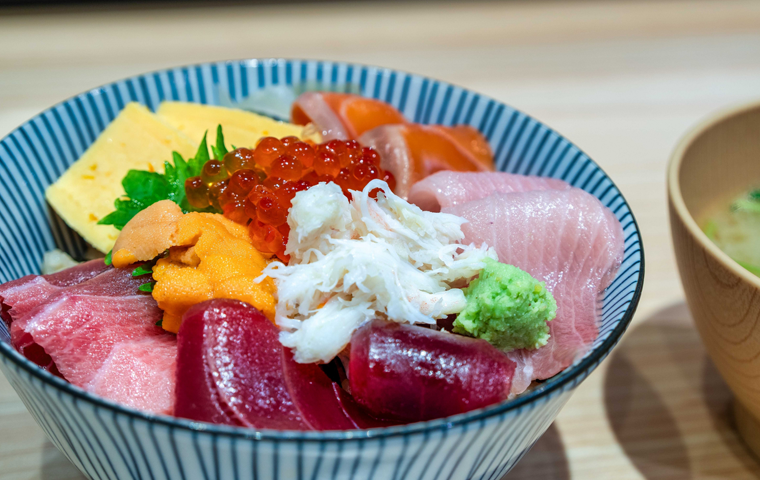Toyosu’s First Auction: A ¥200 Million Tuna Reflects Today’s Japan
Related Articles
Part I: Behind the Frenzy — What a ¥207 Million Tuna Tells Us

In the early hours of January 5, 2025, just after 5:00 a.m., while pre-dawn stillness held sway over Tokyo, the Toyosu Market—one of the world’s largest seafood markets—was charged with its once-a-year electricity. Wholesalers in rubber boots inspected massive frozen tuna by flashlight, gauging quality with grave focus as a distinctive tension filled the hall. At 5:10 a.m., the handbell rang out and the New Year’s first auction began. The booming calls of the auctioneers echoed, marking the start of Japan’s new year in an economic sense as well.
The star of the day was a single Pacific bluefin tuna that drew exceptional attention. Landed off Ōma in Aomori Prefecture, the fish’s imposing frame weighed 276 kilograms (608 pounds)—so large that some overseas media likened it to “the size of a motorcycle.” Tuna from Ōma have an unrivaled reputation as the top brand in Japan’s seafood world, and as the “king of the New Year,” they have virtually monopolized the top price at the first auction. Expectations for its quality only stoked the heat of the bidding.
At the height of the auction, the final price stunned market insiders: ¥207 million (about US$1.3 million). This was the second-highest price on record since 1999, surpassed only by the all-time high of ¥333.6 million in 2019, the first year after the market moved from Tsukiji to Toyosu. The price came to ¥750,000 per kilogram, a figure reported as carrying significance far beyond an ordinary fish transaction.
The historic tuna was purchased jointly by ONODERA GROUP—which operates the high-end sushi brand Ginza Onodera in Japan and abroad—and Yamayuki, a wholesaler of towering repute at Toyosu. This marked their fifth straight victory in winning the “first tuna,” evidence not of luck but of a sustained, deliberate strategy. After the sale, ONODERA GROUP President Shinji Nagao explained the thinking behind the hefty outlay: “The first tuna brings good fortune. We want everyone who eats it to have a wonderful year.” His words made clear that the purchase was not a pure pursuit of commercial profit, but a culturally rooted gesture—invoking auspicious fortune, expressing gratitude to customers, and wishing for prosperity in the new year. Yukitaka Yamaguchi, president of Yamayuki, also stressed that the decisive factor was the tuna’s “exceptional freshness,” underscoring that behind the celebratory price lay a firm appraisal of quality.
The day’s exuberance wasn’t limited to tuna. A single box of purple sea urchin (murasaki uni) from Hakodate, Hokkaidō fetched an astonishing ¥7 million, more than four times the previous record. This suggests Toyosu’s first auction wasn’t just about a single headline-grabbing item; rather, the entire market pulsed with the festive uplift of a “congratulatory market”. In other words, the tuna’s ¥207 million price wasn’t an isolated event but the climax of a grand cultural performance distilling the business community’s strong expectations and confidence for the year ahead.
Part II: The Winners’ Strategy — Why Companies Invest in the Hundreds of Millions
A price tag of ¥207 million defies ordinary business metrics. Thousands of sushi pieces can be cut from the fish, but according to Executive Corporate Chef Akifumi Sakagami, the cost comes out to roughly ¥30,000 per piece. Even so, ONODERA GROUP offered this top-grade tuna at its conveyor-belt brand Kaiten Sushi Ginza Onodera for the jaw-dropping price of ¥1,160 for two pieces. When reporters asked President Nagao whether such pricing was “sustainable,” he candidly replied, “It’s not,” adding, “It’s an auspicious offering,” revealing the true purpose.
This is a classic loss-leader strategy: the profit doesn’t come from the product itself, but from the immeasurable value it unlocks—namely, global media exposure and the massive advertising effect that follows. Considered as the cost of a worldwide PR campaign, even a nine-figure yen “loss” can be an efficient investment. Winning the first tuna is a dramatic way to signal to the world that the company relentlessly pursues the highest quality—and has the ability to pass that quality on to customers.
What sets ONODERA GROUP’s approach apart from past winners is its explicitly global orientation. Ginza Onodera, the company’s Michelin-starred flagship brand, spans key cities: the main house in Tokyo’s Ginza, locations in Hawaii and Houston in the U.S., and shops in Kyoto, among others. The winning “first tuna” is served across this global network—from the pinnacle Ginza counter to kaiten outlets in Kyoto and Osaka, and even at special events such as the “Isetan Umaimono-ichi” gourmet fair at Isetan Shinjuku. In short, the traditional New Year’s “first auction” is being leveraged as a strategic asset to build a global luxury brand.
This contrasts with the path blazed by Kiyoshi Kimura, the “Tuna King” of the sushi chain Sushizanmai. Kimura captivated the media with his charismatic persona and won the first tuna many years running, but his message was aimed largely at domestic audiences—gratitude to Japanese customers and a bid to boost national spirits. His 2019 record-setting purchase was a one-time spectacle showcasing individual passion and showmanship.
ONODERA GROUP’s five-year streak, by contrast, symbolizes a sustained, methodical brand strategy driven by a global company rather than an individual personality. They are not enthroning a “king,” but systematically consolidating corporate standing in the market. This shift in “winners” is more than a change of cast: it reflects a broader transformation in which Japan’s high-end sushi is evolving from a beloved domestic food culture into a globally viable luxury product. Today, Toyosu’s first auction has become a premier stage for competing global brand value.
Part III: The Economics of “Congratulatory Prices” — An Unexpected Link Between Tuna and the Economy

The eye-popping sums at Toyosu’s first auction are known as “go-shūgi prices”—festive premiums paid not only for intrinsic product value but also as an auspicious wish for prosperous business in the new year. The very ability of companies to pay such prices has long been watched as a mirror reflecting not only their own financial health, but also Japan’s broader economic sentiment and expectations for the future.
Economist Akiyoshi Takumori characterizes the first-auction high price as a “leading signal light” for the business cycle, noting an intriguing correlation with stock prices. According to his analysis, between 2008 and 2025 (18 years), there were nine years in which the per-kilogram price of the top tuna exceeded ¥100,000. In eight previous instances when that condition was met, the Nikkei 225 rose for the year without exception, with an average annual gain of +23.2%. The 2025 per-kilogram price was ¥750,000, which by this rule of thumb can be read as a highly bullish signal. Notably, in the four past years when the total winning bid topped ¥100 million, the Nikkei logged double-digit gains each time; with the figure topping ¥100 million for a second consecutive year in 2025, the result could be a strong tailwind for the stock market.
This improving sentiment has concrete underpinnings. In particular, the robust post-COVID rebound in inbound tourism has delivered significant benefits to the food-service sector, and is seen as one driver behind the lofty auction prices—corporate investment appetite backed by real demand.
Curiously, this modern data analysis aligns with an old Japanese market adage tied to the zodiac—“Tatsu-mi tenjō, uma shiri-sagari…”—which suggests that Dragon years (2024) and Snake years (2025) tend to see market peaks. Looking back over 75 years, the Nikkei’s average gain in Snake years is +13.4%, outperforming the overall average. The euphoria at the 2025 first auction thus resonates with traditional market lore, reinforcing optimism about the year ahead.
The trajectory of first-auction prices vividly reflects the emotional ebbs and flows of Japan’s economy in recent years. The all-time high in 2019 symbolized the crest of the pre-pandemic boom. Prices then plunged as the food-service industry struggled through COVID. A powerful rebound to the second-highest level in 2025 stands as a declaration of confidence that Japanese firms have emerged from a long tunnel and returned to a path of solid growth. These prices do more than function as economic indicators; they serve as psychological leading indicators that speak directly to public sentiment. As media nationwide splash headlines about a “¥200 million tuna,” an optimistic narrative—“Japan’s economy is okay”—takes shape, lifting consumer and investor sentiment and stimulating economic activity. In that sense, go-shūgi prices may not only predict the economy—they might help create it.
Part IV: From Near-Extinction to the Dinner Table — The Recovery of Pacific Bluefin
The dazzling spectacle of Toyosu’s first auction has long been shadowed by serious environmental concerns. The star of the show, Pacific bluefin tuna, once saw its stock fall to historic lows due to overfishing, raising fears of extinction. When the all-time price record was set in 2019, international media pointed out that the sum had been paid for an endangered species, casting a critical eye on Japan’s consumer culture. The tension between cultural festivity and conservation ethics was a central dilemma of the event.
But the story behind the 2025 first auction is decisively different: it is one of remarkable success in resource management through international cooperation. Strict catch limits and management measures introduced by bodies including the Western and Central Pacific Fisheries Commission (WCPFC), of which Japan is a member, have borne fruit, and Pacific bluefin stocks have rebounded dramatically.
Environmental groups such as WWF Japan have assessed that Pacific bluefin stocks have returned to a “safe level” a full 13 years earlier than the original target year of 2034. The recovery has been so robust that, based on scientific evidence, the WCPFC formally decided to increase quotas for both small and large fish. Considering the previous crisis, this is a landmark turnaround. At WCPFC meetings, some parties even hailed the Pacific bluefin recovery as a success story worthy of celebration.
This new context of stock recovery fundamentally changes the ethical meaning of Toyosu’s first auction. No longer need the celebration be haunted by guilt over consuming an imperiled species. Rather, the 2025 “first tuna” can be seen as a symbol of a marine resource rescued from crisis and set on a path of sustainable management through international cooperation. Of course, challenges remain for the future—such as establishing long-term Management Strategy Evaluation (MSE) frameworks—but the imminent risk of collapse has been averted.
In that sense, Toyosu’s first auction has rewritten its own narrative. What once risked being perceived as a symbol of disregard for the environment has now, perhaps unexpectedly, become a showcase for one of the world’s most successful marine conservation efforts. The ¥207 million price celebrates not only the value of a fish or the vigor of the economy; it also toasts human wisdom and effort in reviving a natural resource once driven to the brink. This richer narrative is the most vital and powerful message that Toyosu’s 2025 first auction sends to the world.



